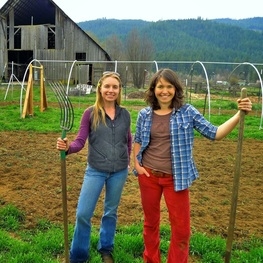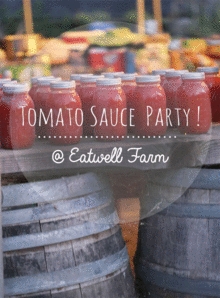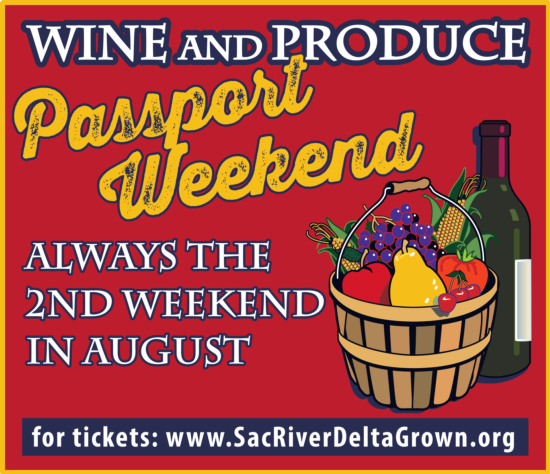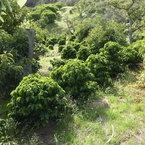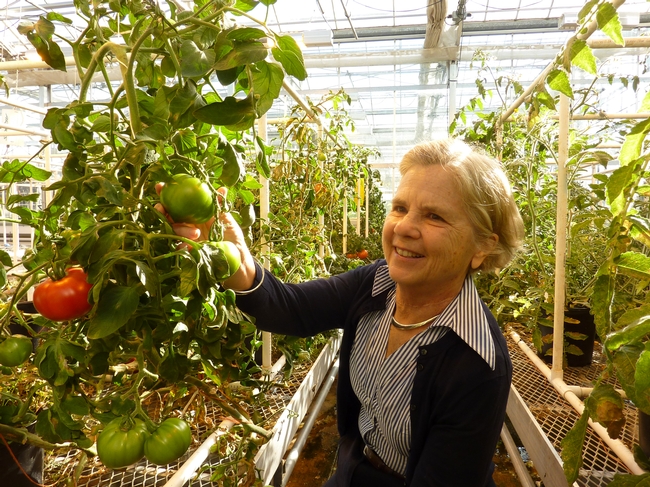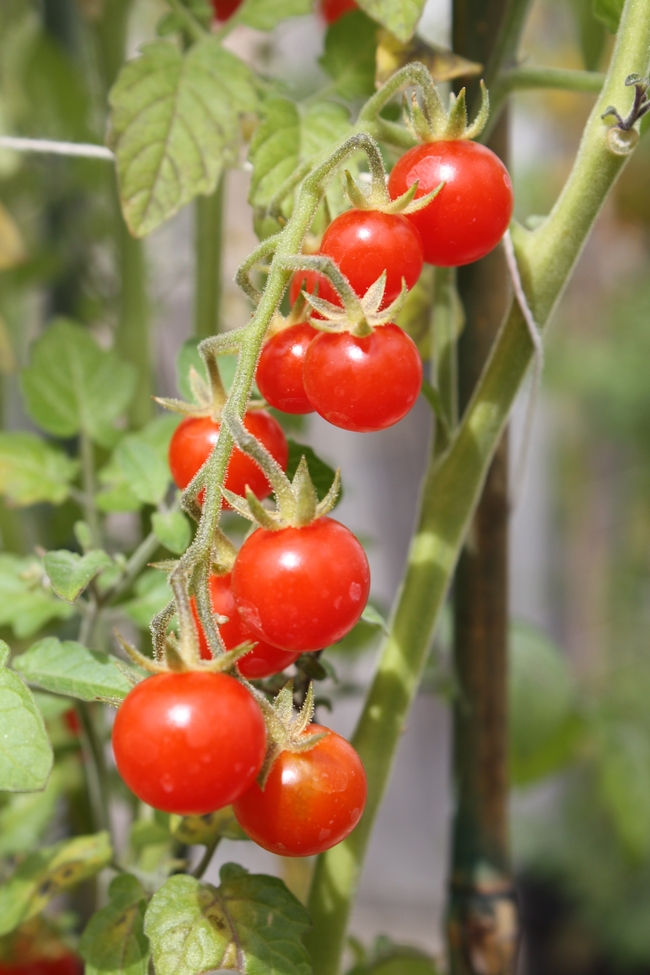Posts Tagged: tomato
Summer farm fun
This time of year, most farmers don't get much sleep. Tomatoes, pears and peaches often ripen in the Sacramento Valley faster than the harvest crews can pick them, even working 12-hour days. But this is also the season that some farmers are happy to show off their farms to visitors, inviting guests to enjoy the delightful flavors and beauty of the harvest in a pause from the bustle. UC Cooperative Extension hosts an online agritourism directory and calendar, www.calagtour.org, to help Californians find farms and ranches to visit. Here are a few upcoming opportunities for summer fun on California farms, pulled from the calendar:
- Plumas County Farm Crawl - Up the Feather River Canyon, on the eastern side of the Sierras, are the beautiful communities of Quincy and Indian Falls. Small-scale growers, members of Plumas Grown, offer tours and fresh snacks from their fields from 8 a.m. to 12 p.m. on Saturday August 6, 2016. Each farm will offer tours on the half hour (8:30, 9:30, 10;30 and 11:30). Participating farms include a school garden project, Five Foot Farm, Shoofly Farm and Sundberg Growers. Strawberries, tomatoes, garlic, carrots, huge heads of lettuce, hoop houses, and intense cultivation on small plots will be featured. Bring the kiddos, friends and family (no dogs please). All of these operations use sustainable growing practices and are happy to chat with you about why they love to grow good food. Admission by donation, no pre-registration required. Learn more: (707) 217-6415 or www.plumasgrown.com/
- Good Humus Peach Party (Yolo County) - Every year on the first Saturday in August, Jeff and Annie Main, owners of 20-acre Good Humus Produce, hold a celebration to give thanks for the year's fruit harvest. They invite you all to come out, see the farm, have a refreshment and enjoy all that Good Humus has to offer. This is a pot luck party; guests are asked to bring a dish to share and their own plates, silverware and cups. No cost, but donations are welcomed. The Mains will provide peach pies, peach ice cream, peach salsa, peach pizzas, and more. You are invited to come early and be part of the experience of making all the peachy fun food. Other activities include a treasure hunt, farm tours, stock tank dipping, music and neighborly chat. Saturday August 6, 1 p.m. - 11 p.m. Learn more
- Tomato Sauce Party at Eatwell Farm (Solano County) - It's time to join in on the tradition. Let's get canning! Tomato season is in full swing on the farm, and the plants are bursting with ripe and juicy tomatoes ready for picking. Join us as we harvest the bounty of the farm, toss it in a pot, and create delicious tomato sauce to savor the rest of the year. The produce is free, so bring as many jars as you can process over the two day event. The ticket price covers the cost of hosting the event and paying staff. Cost: adults $20, Children $5. August 6 - 7, 2016 Learn more and buy tickets here
- Grape Days of Summer (Placer County) - Celebrate PlacerGROWN — local wine, local food, local agriculture. Take a self-guided tour of up to 20 wineries, taste foothill wines and enjoy a unique and educational experience at each stop on the Placer County Wine Trail. Saturday & Sunday, August 6 & 7, 11 a.m. to 5 p.m. WHERE: Placer County Wine Trail - Auburn, Lincoln, Loomis, Meadow Vista, Newcastle & Rocklin. Activities: Learn About Wine & Wine Making • Live Music at Some Locations • Food at Every Winery • Barrel Tastings • Vineyard Tours • Vertical Tastings • . . . and more! Tickets: Weekend Pass - $45.00, Sunday Only - $25.00/person, Designated Driver - $10.00/person website, more info
- Wine and Produce Passport Weekend (Sacramento River Delta) - Just minutes from Sacramento and Elk Grove, along scenic CA Hwy 160, Delta Farm and Winery Trail members will open their farms and wineries to the public. Farms are open from 9:00 a.m. to 5:00 p.m. and wineries from 11:00 a.m. to 5:00 p.m. During Passport Weekend, enjoy farm tours, local wine tastings, farm equipment displays, and contests. Fresh produce - including tomatoes, pears, melons, squash, stone fruits, sweet corn, zucchini, beans, eggs, and organic produce - will be readily available at many of the farms. Saturday and Sunday August 13 and 14. Tickets: adults $25 in advance, $35 week of purchase and are valid for both days. Kids under 21 are free. Tickets are available for purchase online at www.deltapassport2016.eventbrite.com. Each visitor over 21 will receive a wine glass at their first winery stop. sacriverdeltagrown.org/
- Good Land Organics Coffee Tour (Santa Barbara County) - The tour will be lead by Good Land Organics owner and grower, Jay Ruskey. You will be welcomed with fresh coffee, freshly made juice and seasonal fruit. Jay will give an overview of the coffee research collaboration that has been conducted with the assistance of the University of California Small Farm Program. He will then lead you on a moderate level hike where Ruskey will explain the dynamics of new crop adaptation and integration of organic tree fruit agriculture. The walk will take you through the eclectic mix of exotic fruit varieties that grow on the farm. Each person will have an opportunity to taste a fresh picked coffee berry and discover the original flavors of the coffee bean, while discussing coffee cultivation and post harvest processing. On your return hike, there will be time for open discussion and for any further questions. At noon you have the option to enjoy your picnic lunch at our pond. August 13, 2016, 10:00 a.m. - 1:00 p.m. Cost: $50 per person. website, reservations
Learn about more farms, ranches and adventurous fun at www.calagtour.org.
UC Davis tomatoes provide year-round healthful eating for college students
At the same time, chefs and food buyers at universities, particularly the University of California, are selecting for high-quality fruits and vegetables, produced locally and sustainably. Universities with strong food sustainability programs are rightfully proud of what they're doing to educate students about food production, health, and nutrition. UC Davis Dining Services prioritizes the purchase of locally grown food (ideally within a 50-mile radius of campus). Most University of California campuses have similar programs.
At UC Davis, fresh roma tomatoes are picked each August from the 300-acre Russell Ranch, part of the campus's Agricultural Sustainability Institute, then processed within hours by campus Dining Services to provide year-round tomato sauce for pizza, pasta, and ratatouille. All told, 10,000 pounds of tomatoes are processed during a two-week period in August. About 29 percent of the total food served in the campus's residential dining halls is from local, organic or sustainable sources.
The tomatoes grown at Russell Ranch are part of a long-term academic research project that examines factors such as farming methods, irrigation needs, crop rotations, yield, and nutritional content. At the end of the growing season, some of the many tons of tomatoes are purchased by Dining Services at market value.
Emma Torbert, an academic coordinator at the UC Davis Agricultural Sustainability Institute, noted, “Connecting the food system to the research is really interesting. A lot of times there is confusion about where our food is coming from. The more people are educated, the more educated decisions they can make.”
Many UC Davis faculty and staff are so impressed with the food choices at the dorms that they purchase individual meal tickets and enjoy lunches made with the campus-grown tomatoes, herbs, and other vegetables, all of which are part of the daily food array. Public dinners are also offered periodically at the dorms so that community members can sit amongst students to taste and learn about the sustainability programs in the dorms.
Additional Information:
- Video: Farm to Table, UC Davis Tomatoes; 2010
- Slide show of this year's UC Davis tomato harvesting and processing system; 2014
- Sustainable Foodservice Progress Report 2014, UC Davis Dining Services
- Two videos of UC Davis students who work at the Student Farm to produce food, including one on tomato sauce production
- “Tomatoes: Safe methods to store, preserve, and enjoy.” UC Agriculture and Natural Resources, free publication
Discovery could deliver vintage flavor to a tomato near you
People often complain about grocery store tomatoes, saying they’re too hard and don’t have the flavor we remember from the days of old. And we thought we knew why - because the millions of tons of tomatoes harvested in the United States and beyond have to be picked before they’re fully ripe and juicy in order to survive being shipped long distances. What’s more, many shoppers store their tomatoes in the fridge, which destroys both their flavor and texture.
But guess what? It’s not just how tomatoes are grown, harvested and stored that affect their flavor. A research team led by Ann Powell, a biochemist in the UC Davis Department of Plant Sciences, has discovered a gene mutation that diminishes a tomato’s flavor even if the fruit is picked ripe and stored well. The finding, which was reported in the June 29 issue of the journal Science, identifies a gene that was unknowingly bred out of modern cultivated tomatoes and plays a vital role in producing the sugars and aromas that make heirloom tomatoes so tasty.
The news is unexpected and encouraging, because now breeders have the genetic information they need to create modern varieties suited for large-scale harvest and shipping with all the flavor of more delicate heirloom varieties.
“Now that we know that some of the qualities that people value in heirloom tomatoes can be made available in other types of tomatoes, farmers can have access to more varieties of tomatoes that produce well and also have desirable color and flavor traits,” Powell said.
It takes awhile to breed a new tomato variety, so don’t expect to taste the results anytime soon. But Powell and her team’s discovery is a huge first step. Tomato lovers can also be grateful for C.M. Rick Tomato Genetics Resource Center at UC Davis, home to a vast collection of mutant and wild species of tomatoes which provides the genetic diversity scientists and breeders need to recapture the flavor of old.
You can read more about the study here.
You can access the Science article here.
You can learn more about the C.M. Rick Tomato Resource Center here.
Survey identifies 19 produce candidates for a farm-to-WIC program
A new federal voucher that gives low-income women access to a range of fruits and vegetables could provide unique new marketing opportunities for California growers.
In 2009, the federal Special Supplemental Nutrition Program for Women, Infants and Children (WIC) began distributing monthly cash vouchers to low-income women with children to buy fruits and vegetables. The program reaches almost half of the infants and one-quarter of children under 5 years old in the United States.
A team of UC Cooperative Extension (UCCE) researchers and nutrition advisors has been exploring the possibility of developing a farm-to-WIC program that would link these low-income consumers with local growers. The purpose of such a program would be to increase the consumption of a wide variety of fresh produce, with a focus on locally grown produce when available.
UCCE conducted a survey of produce preferences and buying habits among WIC participants in Tulare, Alameda and Riverside counties in 2010. The full study is published in the January-March 2012 issue of California Agriculture journal.
Based on the results, the UCCE team developed a list of 19 produce items to promote in a possible new farm-to-WIC program. They are:
|
|
|
Although mustard greens and collards were not popular across all sites, the advisors gauged a potential market in Alameda County, so these were retained. Based on write-in responses, oranges were also added.
In California, which has the nation's largest WIC program, 82 local agencies serve about 1.43 million participants at 623 local centers, and WIC participants can redeem their monthly vouchers at 4,000 grocery stores statewide. About 40 percent shop at WIC-only stores, which stock and sell only WIC-authorized foods.
Stocking produce is relatively new to WIC-only stores; before rollout of new WIC food packages in October 2009, these stores were only required to stock limited amounts of fresh carrots. In the survey, most WIC participants (58 percent to 72.3 percent) responded that their preferred stores offered many choices, but fewer participants (18.5 percent to 41 percent) rated the produce quality as “excellent.” Key factors determining purchase decisions were produce quality and freshness, and nutrient value (vitamins and minerals). Cost was relatively less important, possibly because WIC participants procure the produce with the vouchers.
The list has served as a starting point for discussions with growers and WIC vendors.
“The survey showed that WIC participants were interested in purchasing fresh produce with better quality and more variety,” wrote lead author Lucia L. Kaiser, Cooperative Extension specialist in the UC Davis Department of Nutrition, and co-authors, in California Agriculture. “Some WIC participants that we surveyed said they avoided shopping at WIC-only stores in part because these interests were not met.”

A dish made with nopales (cactus pads).
I say tomato!
Here we are, a month into summer, and one of my favorite fruits is starting to emerge: Luscious tomatoes, fresh off the vine.
I know, most of us treat tomatoes like a vegetable in the kitchen, slicing and dicing them into dishes that are savory rather than sweet. Botanically speaking, tomato is a fruit because it’s developed from the ovary in the base of the flowers and contains the seeds of the plant (though cultivated forms may be seedless.)
No matter, the tomato is a nutritional powerhouse any way you cut it, loaded with vitamin C, vitamin A, potassium and lycopene, an antioxidant credited with preventing both cancer and heart disease.
The UC Davis Department of Plant Sciences devotes many resources to tomato production, helping large- and small-scale growers, organic and otherwise, control weeds, manage pests, fight disease and tackle all the other adventures farming can bring. The department is also home to the C.M. Rick Tomato Genetic Resource Center, the largest known collection of tomato seeds in the world. You can’t breed a better tomato without diversity of genetic tissues, and the repository and its abundance of wild species are the sources of resistance to 44 major tomato diseases and at least 20 insect pets – not to mention improved fruit traits like tolerance to saline conditions and drought.
Of course, growing or buying a tomato is only part of the equation. How do you make sure the fruit of your labor is tasty and safe? Here are some helpful hints from the UC Davis Postharvest Technology Center, a handy resource for all your postharvest technology needs:
How to choose: A ripe tomato will be plump, vibrant in color and fairly firm to the touch. You want it to have a little give, but not much. Ageism aside, avoid a tomato with wrinkles.
How to store: Keep tomatoes at room temperature, away from direct sunlight, with the stem scar (the belly button, if you will) facing up to reduce softening and darkening of the fruit. It’s best to eat them within two or three days, though some tomatoes are perfectly fine for about five days. Store tomatoes unwashed and then rinse them under running water before eating.
How to prepare: After rinsing your tomato well, wipe it dry and cut away the stem scar and surrounding area before slicing into it. Don’t wash tomatoes in a sink filled with water (nor use soap or detergent) because tomatoes can absorb contaminated water and soap residue through its stem scar. Cut or chopped tomatoes (and dishes like salsa) should always be covered and refrigerated if not consumed within two hours or preparation. Cut tomatoes will last one or two days in the refrigerator.
How to enjoy: Enjoy them every which way! It would be hard pick my favorite tomato recipe, but you can’t go wrong with this fast, fresh salad:
Tomato platter special
Four fresh tomatoes of any color or variety
Two red onions
Two orange, yellow or red bell peppers
A few sprigs of basil
Your favorite vinaigrette
Four ounces Feta cheese
Slice the produce into circles and fan them out on a platter in an attractive, alternating order. If you have fresh cucumbers, they fit nicely in this flower, as well. Drizzle with vinaigrette, crumble on some Feta cheese, give a few grinds of fresh pepper and few shakes of salt and place basil sprigs on top.
Delish.
You can read more tomato tips from the Postharvest Technology Center here and explore many more of their practical publications here.


